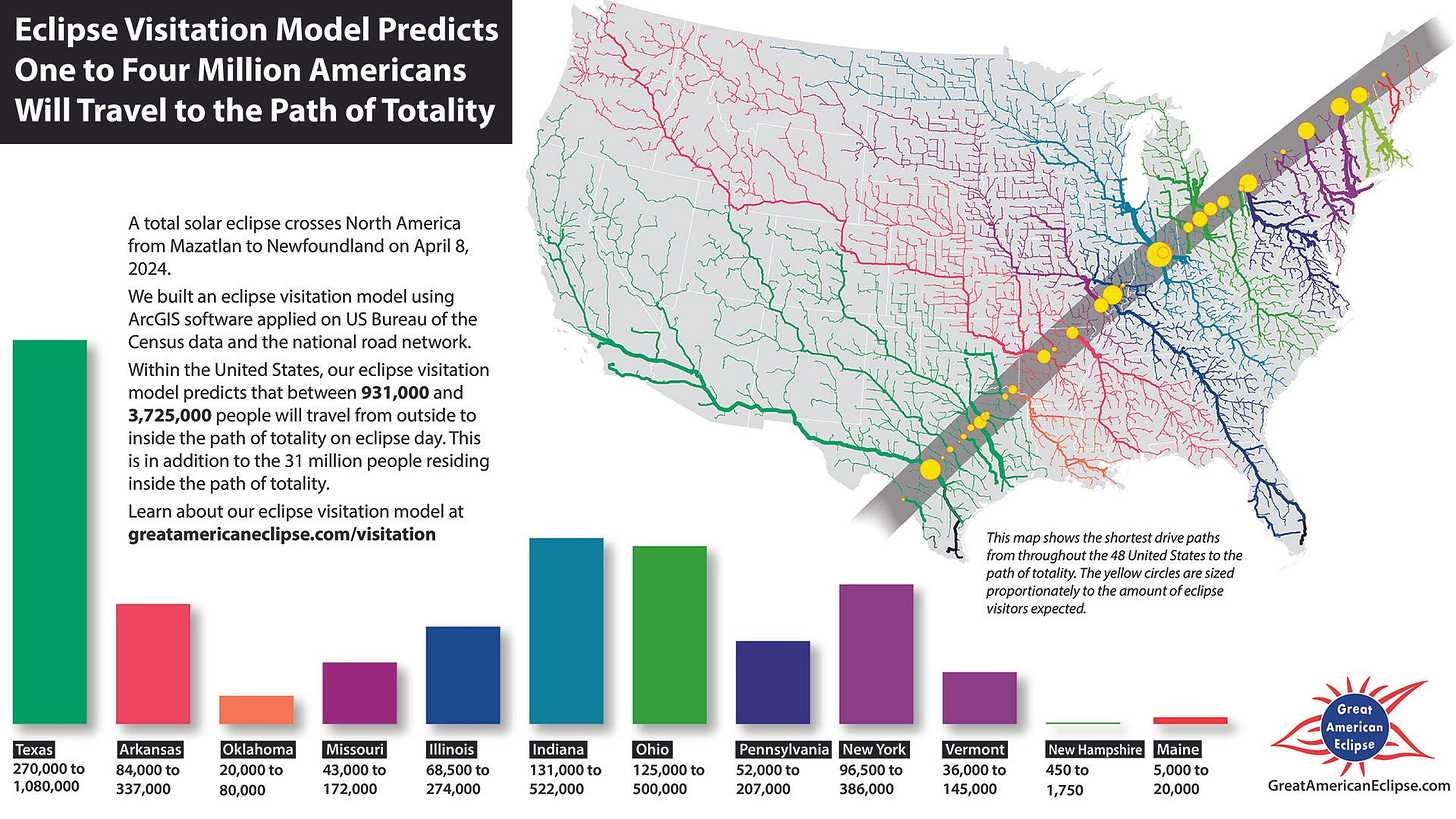Here Comes the (Blocked) Sun
While the moon obscures the sun throughout the day, we can use this opportunity to shed light on the intricacies of economics unfolding beneath its shadow.
You are reading Monday Morning Economist, a free weekly newsletter that explores the economics behind pop culture and current events. This newsletter lands in the inbox of more than 4,200 subscribers every week! You can support this newsletter by sharing this free post or becoming a paid supporter:

From Mazatlan to Montreal, a total solar eclipse will sweep across North America today, casting a shadow over cities, towns, and the eyes of millions. But there’s more to this day than just astronomical wonder. While the moon blocks out the sun at various times throughout the day, we can use today to highlight some of the economic concepts unfolding beneath its shadow. The eclipse’s path of totality—those areas where the full eclipse can be witnessed—promises a memorable experience for fans of astronomy and economics.
From the bustling activity in accommodations to the decisions being made by spectators, vendors, and local governments, the solar eclipse is providing lessons in scarcity, demand, and the consequences of human behavior on a larger scale. While millions may gaze toward the sky today, we’ll look more closely at the economic behavior playing out on the ground.

The Opportunity Cost of Seeing the Eclipse
In the build-up to today’s eclipse, a common concept has been considered in countless decisions across the continent: opportunity cost. It’s a measure of what we give up when we choose one path over another. It affects the decisions of both those who’ve decided to chase the eclipse and those who decide to continue with their day, attending work or school like it’s any other Monday.
For the people seeing this year’s eclipse, whether you’re in the path of totality or not, the opportunity costs include lost wages from taking time off work, the school lessons missed, and the money and time spent on travel. What these people hope to gain must be larger than those costs—a once-in-a-lifetime event, memories with family and friends, and the joy of participating in a collective moment of awe and wonder with others.

On the other hand, there will be millions of people who will treat today just like any other Monday. Their opportunity cost may be too high or they don’t see the benefit being as large compared to what they need to get done today at that time. Economics, at its core, is about making choices under conditions of scarcity and this day offers the perfect chance to think about how opportunity costs might even be useful in explaining why people may not step outside for a few minutes in the middle of the day. Each person’s decision is shaped by their values, circumstances, and the weight they place on the expected benefits.
A Lodging Boom Along the Path of Totality
As the eclipse carves its path across the sky, it also leaves behind a visible trace of economic activity on the ground below, especially in the lodging sector. There has been a significant increase in demand in the weeks leading up to the eclipse, particularly for places to stay along the path of totality—hotels, short-term rentals, and even that cozy nook in someone’s backyard. Prices have followed suit, just as the economic principle of supply and demand would predict.

With the supply of accommodations largely fixed in the short term, the sheer volume of eclipse enthusiasts flocking to these areas has pushed prices to levels seldom seen. In some instances, rooms that would typically rent for $100 per night are fetching prices upwards of $500 or more. For comparison, prices for rooms at chain budget hotels in the city hosting the men’s NCAA basketball tournament final, which also happens today, don’t even come close to the rates being charged for accommodations during the eclipse.
And it’s not just the lodging sector feeling the impact. The influx of visitors has also been seen at local restaurants and shops over the past few days. Many of these communities rarely see such levels of activity. Residents along the path have gotten creative, renting out everything from spare bedrooms to patches of their lawn for tents. This entrepreneurial spirit is a testament to how extraordinary events can turn into opportunities for economic gain.

The Eclipse’s Ripple Effects
As towns along the path of totality swell with visitors, a more nuanced economic concept also comes to light: externalities. These are the unintended consequences of economic activities—both good and bad—that ripple through communities without their choosing.
Shops, restaurants, and service providers find themselves bustling with business as visitors pour in, seeking meals, mementos, and the charm of small-town hospitality. It’s an opportunity for these places to see some additional revenue and showcase their region to a wider audience, with the hopes of drawing visitors for years to come.

But this influx isn’t without its challenges on those same communities. The strain on local infrastructure can be intense. Traffic jams clog roads, and services from water to emergency response face pressures they’re not built to handle. Additionally, the sheer number of visitors can lead to a shortage of essential amenities, notably port-a-potties, leaving many areas underprepared for the basic needs of the crowds.
The overload on cell towers is another significant issue, with the increased demand for connectivity leading to potential network failures just when thousands are trying to capture and share this moment. And then there’s the environmental impact—more litter, potential harm to wildlife, and a footprint that’s hard to erase. Some communities are bracing for the chaos, but this can be a good reminder that our actions impact others around us in more ways than one.
Final Thoughts
This eclipse, like many other significant events, serves as a living classroom to learn about the ways that different economic concepts impact our decisions. I invite you to share your eclipse experiences and the decisions you made in the face of this phenomenon.
How did you weigh the opportunity costs? What impact did the increased demand have on your plans? And how did you perceive the externalities associated with the event? Let’s continue the conversation even after the eclipse passes us by—leave your comments, share your stories, and join us in finding lessons in the choices we make every day.
The eclipse will be visible to 32 million people in the United States who live along the path of totality and 99% of people in the United States will be able to glimpse at least a partial solar eclipse [CNN]
Hotel searches increased 15x for the dates around April 8 compared to the year before, while flight searches increased 304% [Kayak]
One Super 8 in Illinois advertised $949 per night for a Sunday through Tuesday stay, but its normal advertised nightly rate is $95 [The Upshot]
Canada’s Niagara region declared a state of emergency as it prepares for a million eclipse tourists [Fortune]
An estimated 215 million Americans watched the solar eclipse that passed through in 2017 [The New York Times]




